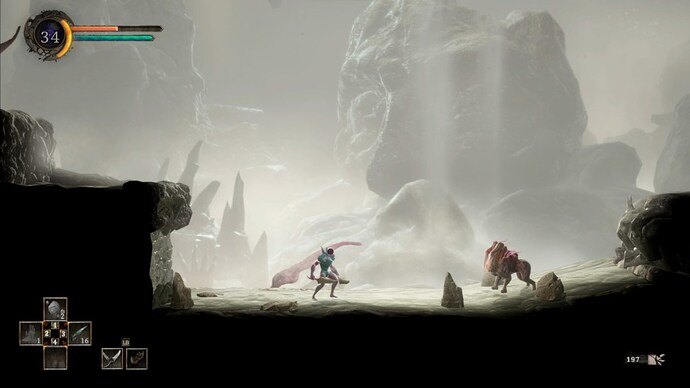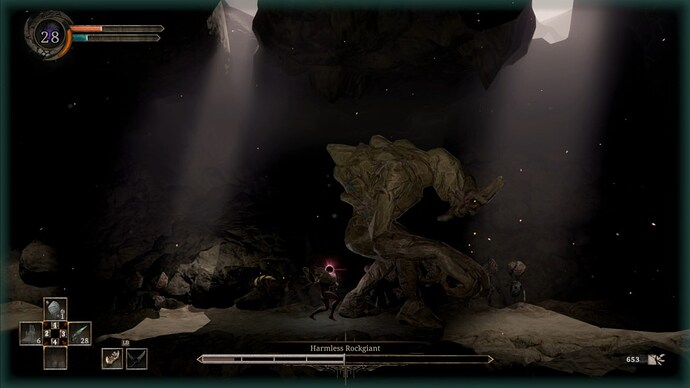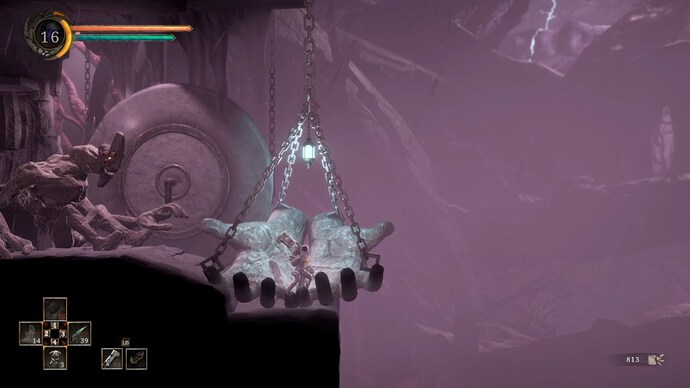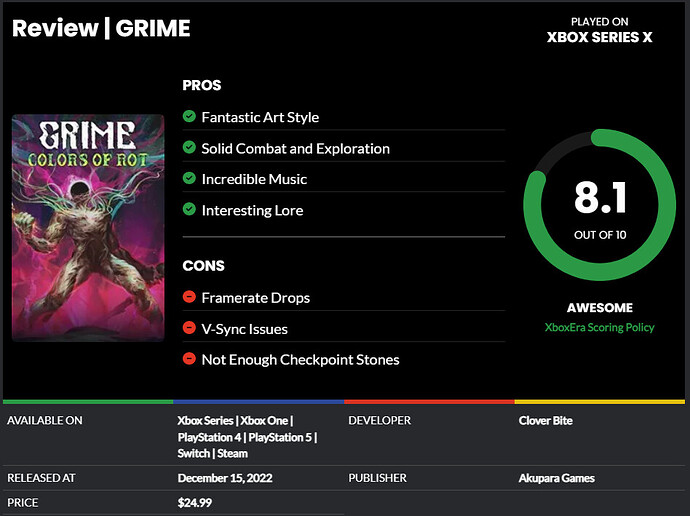Originally published at: Review | GRIME - XboxEra Reviews Review | GRIME
GRIME was recently released on Xbox after being for over a year and a half elsewhere. If you’re like me, you had never heard of it. I only became aware of this Metroidvania Soulslike (an increasingly popular genre) after a review key for it showed up courtesy of ID@Xbox. It had an odd, crazy art style so I started playing and was immediately hooked. This weird, grotesque, excellent game is one of the more out-there and satisfying titles in this burgeoning genre. You are a smooth rock man, smashing oddly shaped rock people to pieces and absorbing their bodies. GRIME is definitely worth your time, so let’s get into it.
Oh, Smooth One!
GRIME begins with two oddly shaped, rock-based celestial beings embracing one another. A golden breath passes between them, and seemingly our protagonist is born. With a black hole for a head and an ever-changing outer rock body, we begin the search for the meaning of our existence. For roughly twelve hours I marveled at the story beats. Nothing is ever handed to you, and even after all this time, the game’s lore is still up for interpretation. Don’t let that scare you away, though, because what is shown is beautiful, weird, and bat poop crazy. I love the look of everything here, the mix of rock and organic matter. Areas both pristine and grime-covered tell their own stories of this strange world everyone is inhabiting.
The breath from the start of the game is a mysterious, and tricky-to-understand force. It empowers your character and all of those you come in contact with, both friend and foe. Early on everything is fragmented rock, shaped to look oddly like life. As you delve deeper you find those who have some remembrance of what life looks like (looked like maybe?). Without spoiling too much just know that GRIME’s environments and inhabitants are constantly hinting toward the overall plot. You will need to pay attention, and if you put the game on the easier difficulty (which is still tough) you can.
GRIME is a Soulslike Metroidvania whoseewhatisit through and through. You will get a resource from vanquishing your enemies and use it to level up a variety of stat trees. On the normal, brutal difficulty you will lose these items on death and have to retrieve them. On the previously mentioned easy version though you never lose your resources on death, which takes the sting out of how difficult the game’s combat can be. This can be changed at any time in the game’s few option screens and kept my frustration down when I ran into a wall progression-wise.
The Gameplay and Systems
Gameplay wise it should feel familiar to anyone who has played a recent 2D Soulslike. For meters, you have a health and energy one (called Force) to start with. As you progress through the game you’ll gain extra abilities but you have a dodge on the B button to start. A is your jump, and while it uses your energy it won’t stop it from replenishing as an attack or dodge will. Attacks are on X and Y respectively. X is your quick slash and Y is your weapon’s special move. There are a lot of weapons, and they upgrade in a similar way to the souls titles as well. After a few hours, you’ll find a blacksmith that can upgrade your weaponry by using your main resource (gained through murder) and another that you find while playing called blood metal.
Depending on which weapons you use, you can carry two at a time, you will need to focus on different stats. There are versions of health, energy, strength, dexterity, and finally resonance which ties into the absorption mechanic and some weapons. Strength weapons tend to be large, heavy, and slow. Dexterity is your faster or bladed types, and the resonance ones are most akin to “magic” types in other titles. GRIME is a deliberate title though, and none of the weaponry will ever feel like you’re in Dead Cells or something focused on twitch movement. An issue I had is that player and NPC models do not always match their hitboxes and I had multiple occasions where taking a hit or death felt like I was being cheated. It didn’t happen often, but it did happen enough that it became a source of frustration by the end of my playthrough.
The unique part of the game is its focus on the parry/absorption system. One of the main ways to defend and deal damage is by using the right bumper to absorb attacks. The window on normal difficulty is small but still generous compared to something like Sekiro. On easy, the window is slightly larger but not by much. Enemies will have various colored attacks, normally red, which you cannot parry. They also have a health meter that will often contain an indicator of how low their health must be before you can absorb them. Absorption is the most important part of the game as it is the only way to heal. After absorbing enough breath (gained when an enemy dies from your parry) you will build up a meter in the top left. Pressing the right trigger will cause a heal-over-time to start up, it’s not instant like an Estus flask, so you’re still vulnerable if you use it while at low health. Defeating certain bosses, normally optional ones, can make the breath meter larger and increase how much health you heal when using it. The Ardor system incentivizes not using checkpoints or being hit. Every time you defeat an enemy the amount of mass you will gain from them is increased depending on your Ardor meter. I was able to level quickly in a few areas by raising my level up quickly and smashing stones in the environment early on. It adds a good bit of balance to the difficulty and gave me even less of a reason to want to be hit. There is a decent amount of platforming in the title and it’s passable at best. You have a good amount of air control, but it never feels tight and it did lead to a few deaths that would have been avoided with a better setup.
Another part of the absorption mechanic is unlocking passive traits. Each enemy type will have a set number of times you need to absorb them, and once reached you can then use an in-game currency called hunt tokens to unlock a new passive ability. Hunt tokens are tied to elite versions of the game’s enemies who never respawn once killed. To use all of the mass and hunt tokens to upgrade you will need to find the checkpoint stones. One of the issues I had with the game is how few of these there are, and the fast travel system you eventually unlock isn’t plentiful enough either. Much like in Hollow Knight, there will be a fair bit of backtracking in GRIME while you’re learning enemy encounters and dying repeatedly. There is a free DLC called The Colors of Rot that was added to the game and should afford you a few hours of extra content once you’ve completed a playthrough of the game. It’s a solid addition that adds in new abilities and bosses and the promise of more DLC to come in the future is an exciting prospect. One issue that games like Hollow Knight didn’t have is with their performance and playing on a Series X I ran into a large number of major issues in GRIME.
Graphics, Performance, and Sound
I stated earlier that GRIME is a beautiful game. The issue you’ll notice immediately on Xbox is the screen tearing and framerate drops. For something that should run just fine on an Xbox One, it is shocking just how often the framerate dropped from 60 to what felt like the 20s on a Series X. While capturing footage for this review I did not have VRR enabled (variable rate refresh), and the screen tearing was atrocious. Even with VRR on after I had gotten the footage I needed, it was still noticeable. GRIME was released in December of 2022 on Xbox, so I’m hoping a patch will hit at some point to fix this as it did with another recent release in Somerville.
Performance issues aside I freaking love the art style in this game. Thankfully the music might be even better. There is no voice acting, and the writing is fine in its limited use, but the music is sublime. From the opening cutscene through the final areas, it is excellent. Sound effects are standard for this type of game and seeming budget behind it. Nothing special, but it never gets in the way of the action by being distracting.
While I only ran into a few visual bugs I was surprised at the loading times on Series X, and how it would randomly load for a second or two while exploring. It’s not terrible, but I wasn’t used to having to hit a few-second loading screen in this type of game whenever I used a new checkpoint pillar. The game does have a good map built into it, another plus over hollow knight types. To unlock each area you follow an incredibly annoying sounding hum to a “resonance pillar” and from there it will automatically update the map as you explore.
Wrapping things up
GRIME is a series of good to great-pieces that are slightly held back by performance issues. Depending on when you’re reading this review I hope those are fixed because this game is fantastic. It’s beautiful, ugly, terrifying, and something any Metroidvania Soulslike fan should love.
![Review | Grime: Colors of Rot [4K]](https://forum.xboxera.com/uploads/default/original/3X/3/5/35be85f0e452a6e3225ad4ccc98b737d35fa9c0d.jpeg)




